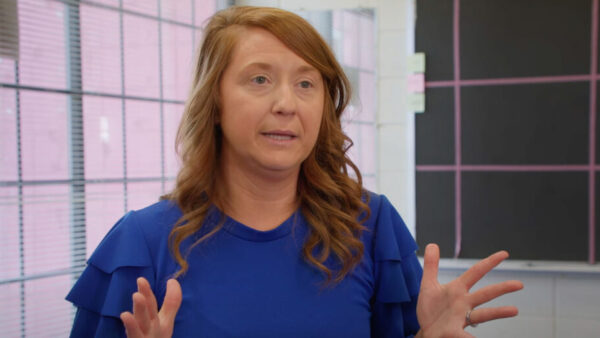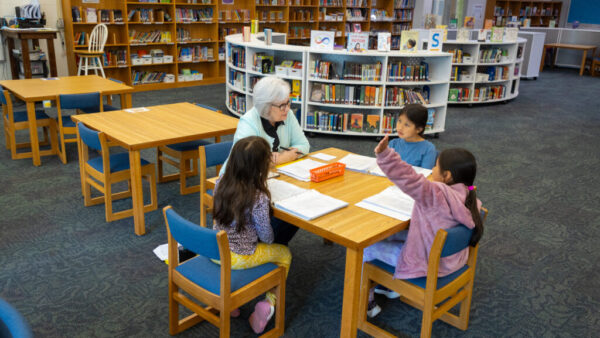PROOF POINTS: Trial finds cheaper, quicker way to tutor young kids in reading

“Short bursts” of phonics in the back of the classroom show promise with kindergarteners
By Jill Barsay, The Hechinger Report
This story was produced by The Hechinger Report, a nonprofit, nonpartisan news outlet focused on education.
Education researchers have been urging schools to invest their $120 billion in federal pandemic recovery funds in tutoring. What researchers have in mind is an extremely intensive type of tutoring, often called “high dosage” tutoring, which takes place daily or almost every day. It has produced remarkable results for students in almost 100 studies, but these programs are difficult for schools to launch and operate.
They involve hiring and training tutors and coming up with tailored lesson plans for each child. Outside organizations can help provide tutors and lessons, but schools still need to overhaul schedules to make time for tutoring, find physical space where tutors can meet with students, and safely allow a stream of adults to flow in and out of school buildings all day long. Tutoring programs with research evidence behind them are also expensive, at least $1,000 per student. Some exceed $4,000.
One organization has designed a different tutoring model, which gives very short one-to-one tutoring sessions to young children who are just learning to read. The nonprofit organization, Chapter One (formerly Innovations for Learning), calls it “short burst” tutoring. It involves far fewer tutors, less disruption to school schedules and no extra space beyond a desk in the back of a classroom. The price tag, paid by school districts, is less than $500 per student.
The first-year results of a four-year study of 800 Florida children conducted by a Stanford University research organization are promising. Half the children in 49 kindergarten classrooms were randomly selected to receive Chapter One’s tutoring program during the 2021-22 school year. Almost three-quarters of the students were Black and more than half were low-income – two groups who are more likely to be held back in third grade because of reading difficulties.
To keep younger children on track, the Broward County school district, where the study took place, wanted all kindergarteners to be able to sound out simple three-letter words by the end of the year and be able to distinguish similar words such as hit, hot and hut. After one year of this short burst tutoring, more than double the number of kindergarteners hit this milestone: 68 percent versus 32 percent of the children who didn’t receive the tutoring in the same classrooms. Tutored students also scored much higher on a test of oral reading fluency.
“These results are big,” said Susanna Loeb, a Stanford professor of education who was a member of the research team and heads the National Student Support Accelerator, a Stanford research organization that studies tutoring and released this study in February 2023. “What’s so exciting about this study is it shows that you can get a lot of the benefits of high impact tutoring – relationship-based, individualized instruction with really strong instructional materials – at a cost that is doable for most districts in the long run.”
Loeb said the reading gains in this study were at least as large as what has been produced by more expensive tutoring programs. But it remains to be seen whether these short-term benefits will endure, and whether kids without tutoring will eventually catch up. Researchers especially want to learn if these tutored children will become proficient readers at the end of third grade, a crucial marker in academic development. By one measure, a third of U.S. third graders are currently far behind grade level in reading and in need of intensive remediation.
The 400 children who received the short-burst tutoring in kindergarten in this study are continuing to receive tutoring in first grade during the current 2022-23 academic year. Researchers are tracking all 800 children, with and without tutoring, for an additional two years through third grade.
Loeb cautioned that this short burst model would be unlikely to work with middle or high school students. It might be that short bursts of one-to-one help are particularly suited to the littlest learners.
“We realized at that young age that their attention span runs out somewhere around six or seven minutes if you’re really doing things intensively with them,” said Seth Weinberger, the founder of Chapter One.
Weinberger stumbled into tutoring after a foray into educational video games. He was originally a lawyer representing video game makers, and collaborated with academics to develop phonics games to teach reading.
“After about 20 years of honing these computer games, we came to the conclusion that computer games by themselves are just not going to be enough,” said Weinberger. “You really need some combination of computer-assisted instruction and actual real live humans in order to make it work for the kids.”
Weinberger’s tutoring-and-gaming model works like this: a tutor sits at a desk in the back of the classroom during the normal English Language Arts (ELA) period. One child works with a tutor for a short period of time, typically five to seven minutes, rejoins his classmates and another child rotates in. Children work with the same tutor each time, but a single tutor can cycle through eight or more students an hour this way.
Though it might seem distracting to have an audible tutoring session in the same classroom, kindergarten classes are often a hubbub of noise as children work with classmates at different activity stations. Tutoring can be another noisy station, but I imagine that it can also be a distraction when the teacher is reading a picture book aloud. Weinberger considers it a strength of his program that kids are not pulled out of the classroom for tutoring so that they are not missing much instruction from their main teacher. In disadvantaged schools, children are frequently pulled out of classes for extra services, which is also disruptive.
Technology plays a big role. Behind the scenes, Chapter One’s computers are keeping track of every child’s progress and guiding the tutors on how to personalize instruction. The tutor’s screen indicates which student to work with next and what skills that student needs to work on. It also suggests phonics lessons and activities that the tutor can use during the session.
The computer guidance takes the usual guesswork and judgment calls out of reading instruction and that has enabled well-trained laypeople to serve as tutors as well as experienced, certified teachers. (The Stanford team is currently studying whether certified teachers are producing much larger reading improvements for children, but those results are not out yet. In the current study I am writing about here, both laypeople and certified teachers served as tutors.)
Chapter One’s technology also determines how much tutoring each child should get each day and how many times a week. Dosage ranges from a two-minute session every two weeks to as much as 15 minutes a day. More typical is five to seven minutes three to five times a week. Children in the middle who are making good progress get the most. Children at the very top and the very bottom get the least. (Children who are not making progress may have a learning disability and need a different intervention.)
Technology is also used to reinforce the tutoring with independent practice time on tablets. Chapter One recommends that every child spend 15 minutes a day playing phonics games that are synced to the tutoring instruction and change as the student progresses. The researchers did not yet have data on how much time children actually spent playing these educational games, and how important this independent practice time is in driving the results.
A federal survey of principals estimates that half of U.S. students are behind grade level, far higher than before the pandemic, when a third were behind. But it’s really hard to expand high-dosage tutoring programs rapidly to serve the millions of children who need it. Most of the effective programs are rather small, reaching only a tiny fraction of the students who need help. What’s heartening about this Chapter One study is that the organization is already tutoring 25,000 students in U.S. schools (plus 1,000 students in Canada and the United Kingdom). Now we have a well-designed study – as close as you get in education to the kinds of tests that we do on vaccines and pharmaceuticals – showing that it is effective.
“It’s not that it has the potential to scale,” said Stanford’s Loeb. “Already 10,000 kids are receiving it in this one district, so we know that it’s actually possible.”



